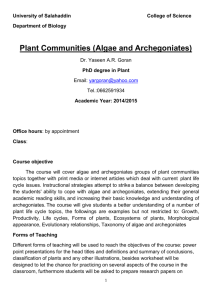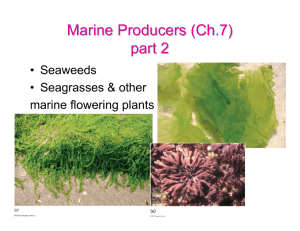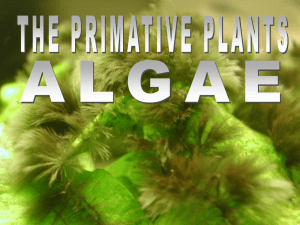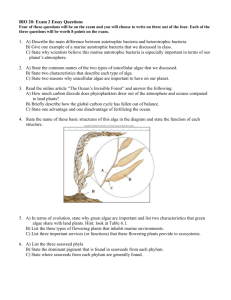Multicellular Primary Producers
advertisement
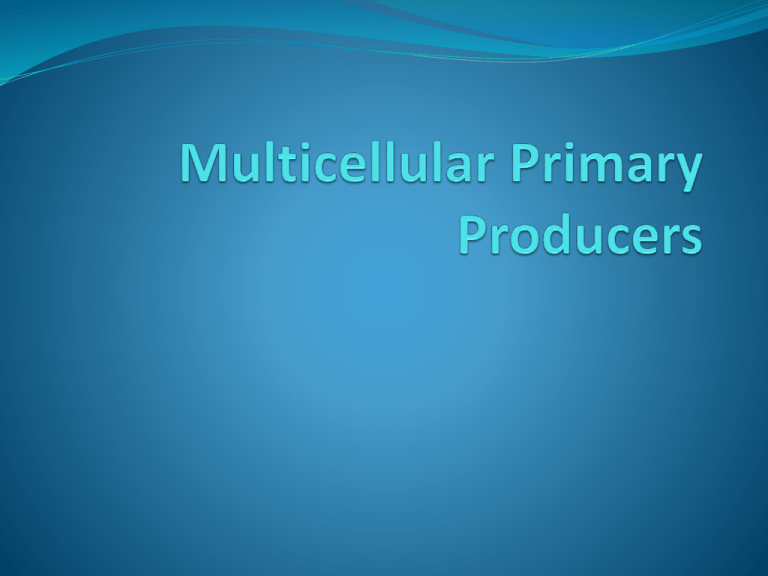
Multicellular Algae Seaweeds ( macroalgae) Multicellular algae Three groups of seaweeds Red algae – phylum(division) Rhodophyta Brown algae – phylum(division) Phaeophyta Green algae – phylum(division) Chlorophyta Rhodophyta Irish Moss - Rich in protein and minerals Corallines Secrete a calcium carbonate shell that bond coral colonies together (holds the coral reef structure together) Nori - Rich in protein and minerals Phylum Rhodophyta Red Algae Corallines Secrete a calcium carbonate shell that bond coral colonies together (holds the coral reef structure together) Irish Moss Rich in protein and minerals Nori Rich in protein and minerals Phylum Rhodophyta Biochemistry Chlorophylls a, d Phycoerythrin (red pigments) Allow some red algae to live much deeper than any other algae As deep as 200 m (656 ft) Phylum Rhodophyta Ecological Roles Seasonal food for herbivores, grazers Some form turfs and reef sediments Some stabilize reef sediments Phylum Rhodophyta Commercial uses Agar Used in medicine and research for culturing microorganisms Carrageenan Desserts, ice cream, milk shakes, sweetened condensed milks, puddings, sauces: gel to increase viscosity thickener : Shampoo and cosmetic creams…. Red Algae – Phylum Rhodophyta Primarily marine (98%) The highest diversity among seaweeds Mostly benthic in distribution Some species are epiphytes (plant living on plant) Coraline red algae- helps to cement loose coral together Important commercial uses Agar – culturing bacteria Carrageenan – thickening agent Source of food for human consumption, animal feed, and used in fertilizer Phylum Phaeophyta Brown Algae Kelp Sargassum Rockweed Rockweed Phylum Phaeophyta Biochemistry Chlorophylls a, c Pigment fucoxanthin Phylum Phaeophyta Ecological Roles Long term food for herbivores, grazers very productive the Giant Kelp is the foundation for many temperate coastal ecosystems: California, the Mediterranean, and New Zealand Kelp form massive undersea forests Habitat for diversity of marine animals Sea urchins, fishes, crustaceans, molluscs, sea lions, sea otters Phaeophyta Brown Algae – Phylum Phaeophyta Rockweeds, kelps, and sargassum Almost exclusively marine (99.7%) Most are benthic except for Sargassum Range in size from microscopic to the giant kelps Olive-brown color is due to pigment fucoxanthin (also found in diatoms) Brown Algae Blades of brown algae usually have gas-filled bladders that help them to stay afloat to get maximum exposure to sunlight The stipe is attached to the bottom by a holdfast Ecological roles of Sargassum Sargassum forms floating mats in the North Atlantic Ocean in an area known as the Sargasso Sea Habitat to a variety of organisms unique to the sargassum Massive mats of sargassum support a complex and diverse community Several species of fish and invertebrates live only in this ecosystem Phylum Phaeophyta Commercial uses Brown algae is used as a food resource Seaweeds and algae make up 10% of the Japanese diet The commercial product algin is used in food processing, salad dressing, ice cream, paint, and abrasives Food and chemical industries use about $250 million worth of algin annually Commercial products from Brown Algae The alginates of some brown algae are harvested for commercial use as thickening agents in the textile, dental, cosmetic, and food industries Brown algae are used as food, and as cattle feed Chlorophyta Phylum Chlorophyta Green Algae Sea lettuce Phylum Chlorophyta Biochemistry Chlorophylls a, b Carotenoids Chlorophyta share the same pigments as land plants Evolutionarily significant, indicates that land plants evolved from green algae Phylum Chlorophyta Ecological Roles Seasonal food for herbivores, grazers Manatees eat sea lettuce Some form turfs and reef sediments Phylum Chlorophyta Commercial uses Can be used as a compost material and as fertilizer Green Algae – Phylum Chlorophyta Contain the same types of pigments that are found in land plants (a,b) Few marine species (13%), most are freshwater and phytoplankton Distribution of Seaweeds Most species of seaweed are benthic Fouling communities – live on pilings, bulkheads, boat hulls... The environmental factors most influential in distribution Light and temperature Structure of Seaweeds Thallus The seaweed body Blade Flattened part of the thallus Holdfast Attaches the thallus to a surface Stipe Stem-like region between the holdfast and the blade Photosynthetic pigments Chloroplasts in all seaweeds have chlorophyll a Green algae also has chlorophyll b Brown algae chlorophyll c Red algae chlorophyll d Composition of cell walls Primarily composed of cellulose Calcareous algae may also have calcium carbonate Reproduction in Seaweeds Both asexual and sexual Asexual Fragmentation Thallus breaks into pieces and each piece grows into a new plant Spore formation Sporophyte produces spores Sexual Gametes are produced and zygote is formed Gametophyte produces gametes Alternation of generations Asexual sporophyte and sexual gametophyte in same plant


